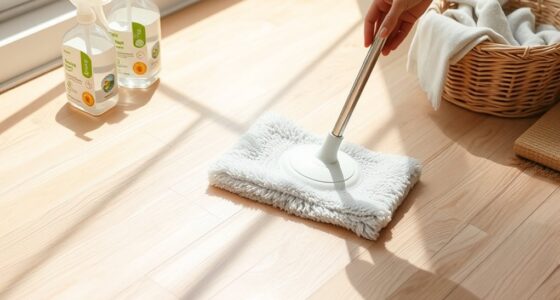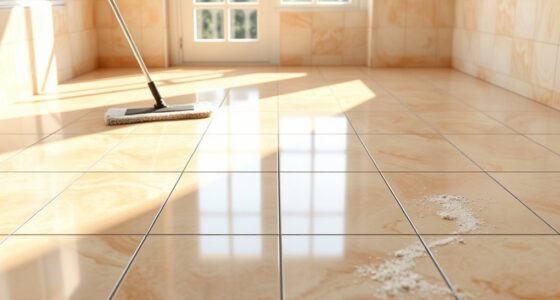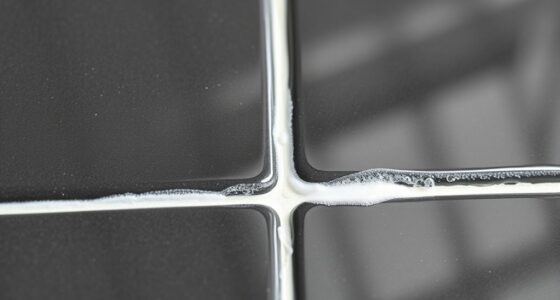Before you start mopping your linoleum floors, make certain any loose dirt and grit are removed with a soft broom or microfiber mop. Place felt pads or sliders under furniture legs to prevent scratches when moving items. Avoid dragging furniture across the surface, and lift heavy pieces instead. This quick prep minimizes surface damage and keeps your floors looking their best. Keep going, and you’ll discover more tips to protect and maintain your linoleum floors effectively.
Key Takeaways
- Remove dirt and grit with a soft broom or microfiber dust mop before mopping.
- Use a damp mop, not soaking wet, to prevent water damage and scratching.
- Rinse the mop thoroughly and change water frequently during cleaning.
- Avoid using abrasive scrubbers or harsh chemicals that can scratch the surface.
- Place felt pads or furniture sliders under furniture legs to prevent scratches during movement.

Linoleum floors are durable and easy to maintain, but scratches can still mar their appearance over time. To keep your floors looking pristine, it’s essential to focus on furniture protection and proper cleaning techniques before you even think about mopping. Furniture can easily cause scratches if you don’t take precautions. For example, sliding heavy furniture across the floor can leave deep gouges that are hard to repair. To prevent this, always lift and carry furniture instead of dragging it. When moving items, place felt pads or furniture sliders underneath the legs. These small additions create a protective barrier that reduces friction and minimizes the risk of scratches. You might also want to rearrange furniture periodically to distribute wear evenly across your linoleum floor.
In addition to furniture protection, adopting the right cleaning techniques is vital. Using the wrong cleaning tools or products can inadvertently cause scratches. Always use a soft-bristled broom or a microfiber dust mop to remove loose dirt and debris before mopping. This step prevents particles from scratching the surface when you clean. When it’s time to wash the floor, opt for a damp mop rather than a soaking wet one. Excess water can seep into seams and cause damage over time, which may lead to scratches and other imperfections. Use a gentle, linoleum-specific cleaner or a mixture of warm water and a few drops of mild dish soap. Avoid abrasive scrubbers or harsh chemicals, as they can scratch or dull the surface. Regularly inspecting your floors for dirt or grit helps maintain their appearance, and using appropriate cleaning tools can prevent unnecessary damage over time. It’s also wise to regularly inspect your floors for dirt or grit that can act like sandpaper when mopped or walked on. Keeping your floors free of debris is an effective form of furniture protection because it reduces the likelihood of scratches caused by moving furniture or foot traffic. When cleaning, always rinse your mop thoroughly and change the water frequently. Dirty water can leave streaks and residues that may attract more dirt, increasing the chance of scratches during subsequent cleanings. Remember, patience and gentle handling are key—rushing and applying too much pressure can cause scratches or wear down the finish.
Frequently Asked Questions
Can I Use Vinegar to Remove Scratches From Linoleum?
You can’t use vinegar cleaning to remove scratches from linoleum, as vinegar is too harsh and might damage the surface. Instead, focus on scratch prevention by using furniture pads and avoiding dragging heavy objects. For minor scratches, you can try a linoleum repair kit or a wax stick designed for floors. Regular maintenance and gentle cleaning help keep your linoleum looking new and prevent further scratches, ensuring long-lasting beauty.
Are There Specific Cleaning Products Best for Preventing Scratches?
Think of your linoleum floor as a delicate canvas that needs special care. For scratch prevention, use cleaning product recommendations designed for linoleum—look for gentle, non-abrasive formulas. These products act like a soft brush, protecting your floor’s surface from damage. Incorporate scratch prevention tips like placing felt pads under furniture and avoiding harsh scrubbers. This way, you’ll keep your floor smooth and vibrant, like a pristine work of art.
How Often Should I Mop My Linoleum Floors?
You should mop your linoleum floors once a week to prevent dirt buildup and keep them looking fresh. Regular mopping helps remove debris that can cause scratches over time, especially if you use a gentle cleaner. If your floors see heavy traffic or dirt accumulates quickly, consider mopping more often. Consistent cleaning not only maintains their appearance but also prolongs their lifespan, keeping scratches at bay.
Do Certain Shoes Cause More Scratches on Linoleum?
Certain shoe types, like high heels or rugged sneakers, can cause more scratches on linoleum floors. Imagine the sharp edges and heavy treads scraping your smooth surface with every step. Your footwear habits matter—wearing shoes with hard soles or rough textures increases damage risk. To protect your floors, opt for soft-soled shoes or slippers indoors, reducing the possibility of scratches and keeping your linoleum looking fresh and pristine.
Can Furniture Polish Help Hide Scratches on Linoleum?
Furniture polish can help hide scratches on linoleum floors, but it’s not a permanent fix. You apply a small amount of the polish to the scratched area, then buff gently to conceal the damage. Keep in mind, furniture polish provides scratch concealment temporarily and may leave a residue. For best results, use a polish specifically designed for floors, and consider professional repair for deeper scratches.
Conclusion
Now that you know how to prevent scratches, your linoleum floor will stay as smooth as a calm lake. Think of each step you take as a gentle brushstroke, preserving its beauty. By taking these simple precautions, you’re guiding your floor through a dance where scratches are just distant echoes. Keep up this routine, and your linoleum will shine like a star in the night sky, resilient and gleaming for years to come.









